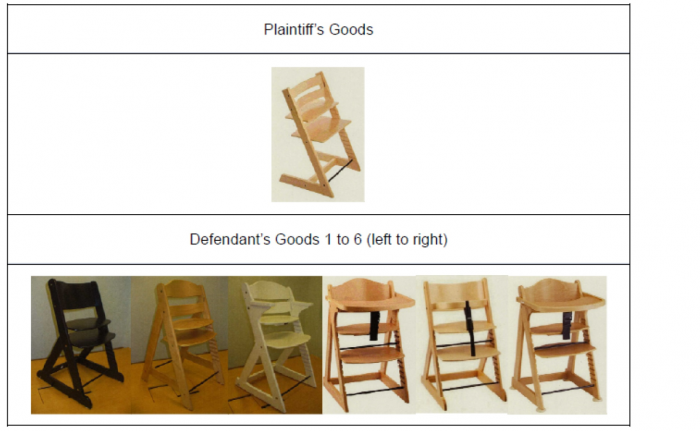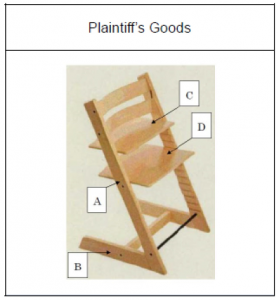2017.12.27
Copyrightability of Applied Arts
TRADEMARK
Copyrightability of Applied Arts
- 1. Introduction
According to the dictionary, “applied arts” means “arts that are put to practical use” or “the application of design and decoration to everyday objects to make them aesthetically pleasing.” Decorated or colored glass cups are good examples. These do not need any decorations or colors to perform their function. It was considered for a long time in Japan that such applied arts should be protected by the Industrial Design Law and not by Copyright Law; however, this idea may or may not be changed. Provided below are two interesting cases in this regard.
- 2. “TRIPP TRAPP” case (H26 (Ne) 10063, IP High Ct., April 14, 2015)
The main issue here is whether the Plaintiff-Appellant’s chairs for infants named “TRIPP TRAPP” (“Plaintiff’s Goods”) are eligible to have copyright protection against the Defendant-Appellee’s Goods with 6 variations. See below.

The court held as follows:
- Applied arts, which are used for practical or industrial purposes, e.g., “chairs for infants,” are also eligible to have copyright protection as an “artistic work” under the definition of Article 10(1)(iv) of the Copyright Law as in the case of other expressions, provided that they meet requirements in Article 2(1)(i) of the Copyright Law. If we say that something is “expressed in a creative way” within the meaning of Article 2(1)(i) of the Copyright Law, such expressions need not necessarily have originality in a strict sense, but must have some individual characteristics of creators. If the expressions are ordinary and commonplace, they cannot be said to have creators’ individual characteristics and be “expressed in a creative way.”
- Here, the Plaintiff’s Goods are considered to have the creator’s individual characteristics in that (i) both the right and left members A are the two legs, and both the member C (a seat surface) and the member D (a foot rest) are fit in and fixed along the gains formed inside the member A; and (ii) the member A is jointed only with the obliquely cut end face of the member B and is in direct contact with the floor surface, and both members form a sharp angle of about 66 degrees. Therefore, the Plaintiff’s Goods are the subject matter under the Copyright Law.

- However, the Defendant’s Goods are not considered similar to copyrightable elements of the Plaintiff’s Goods, and thus, the Defendant’s acts of manufacturing and selling the Defendant’s Goods do not infringe the Plaintiff’s copyright.
- 3. “Edison’ Chopsticks” Case (H28 (Ne) 10059, IP High Ct., Oct. 13, 2016)
The issue here is whether the Plaintiff-Appellant’s (i) “training chopsticks for kids” named “Edison’s Chopsticks” with 19 variations (“Plaintiff’s Goods”) and (ii) the Plaintiff’s Drawing are eligible to have copyright protection against the Defendant-Appellee’s Goods with 20 variations. See below.

The court held as follows:
- In view of the purposes and characteristics of the Copyright Law, industrial property laws such as Industrial Design Law, and the Unfair Competition Prevention Law, industrial goods or designs for practical use should not be the subject matter under the Copyright Law unless, apart from their practical functions, they can be viewed from an aesthetic perspective.
- Here, the number, layout, shape, etc. of rings, being the features of the Plaintiff’s Goods, are designs or structures to achieve the practical function of “training chopsticks for kids” so that kids can learn how to hold chopsticks properly. Also, it is not an expression but an idea to connect chopsticks or to put mascot designs or figurines on the connecting part. In addition, the Plaintiff’s alleged common parts in appearance between the Plaintiff’s Goods and the Defendant’s Goods are not outstanding features in shape. So, the Plaintiff’s Goods do not have such features that, apart from their practical functions, can be viewed from an aesthetic perspective. Likewise, the Plaintiff’s Drawing is recognized as a design for industrial use to manufacture the Plaintiff’s Goods or similar goods. Accordingly, the Plaintiff’s Drawing is neither “a drawing having academic nature” (Article 10(1)(vi) of the Copyright Law) nor an artistic work. In addition, no evidence shows that the Defendant’s Goods were manufactured relying on the Plaintiff’s Drawing.
- In conclusion, both the Plaintiff’s Goods and the Plaintiff’s Drawing are not eligible to have copyright protection against the Defendant’s Goods.
- 4. Our Brief Comments
According to the two cases, it seems still difficult to seek copyright protection of applied arts in Japan; however, it is noteworthy that the IP High Court accepted copyright protection of applied arts (see the above “TRIPP TRAPP” case). If you have no industrial design rights, it may be worthwhile to make copyright claim (in addition to unfair completion claim).
